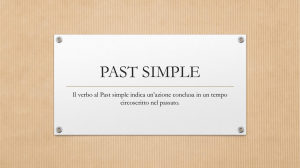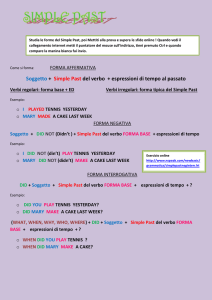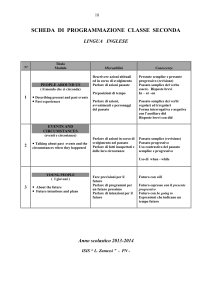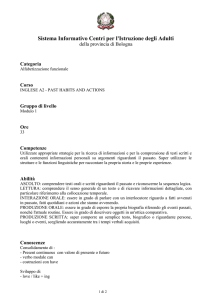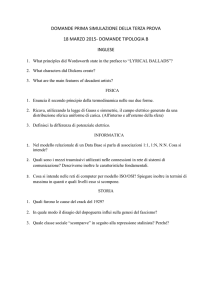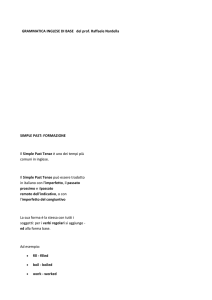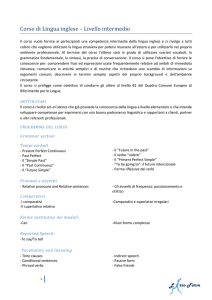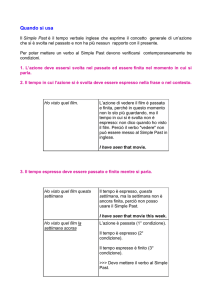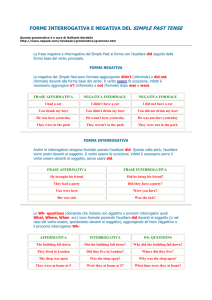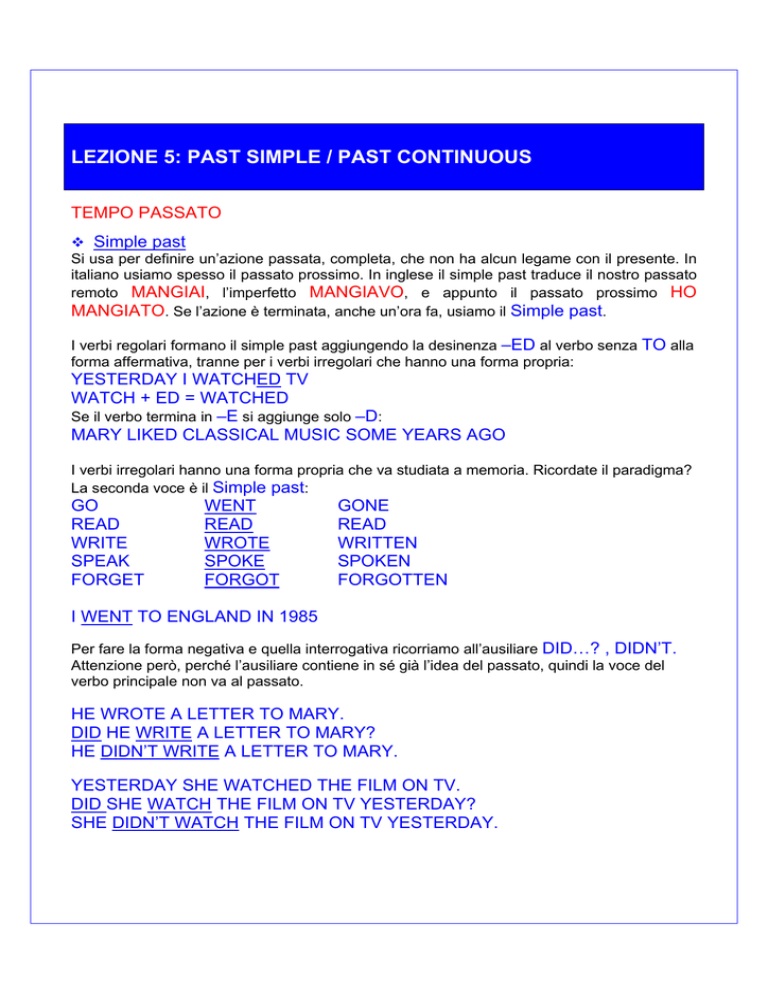
LEZIONE 5: PAST SIMPLE / PAST CONTINUOUS
TEMPO PASSATO
Simple past
Si usa per definire un’azione passata, completa, che non ha alcun legame con il presente. In
italiano usiamo spesso il passato prossimo. In inglese il simple past traduce il nostro passato
remoto MANGIAI, l’imperfetto MANGIAVO, e appunto il passato prossimo HO
MANGIATO. Se l’azione è terminata, anche un’ora fa, usiamo il Simple past.
I verbi regolari formano il simple past aggiungendo la desinenza –ED al verbo senza TO alla
forma affermativa, tranne per i verbi irregolari che hanno una forma propria:
YESTERDAY I WATCHED TV
WATCH + ED = WATCHED
Se il verbo termina in –E si aggiunge solo –D:
MARY LIKED CLASSICAL MUSIC SOME YEARS AGO
I verbi irregolari hanno una forma propria che va studiata a memoria. Ricordate il paradigma?
La seconda voce è il Simple past:
GO
READ
WRITE
SPEAK
FORGET
WENT
READ
WROTE
SPOKE
FORGOT
GONE
READ
WRITTEN
SPOKEN
FORGOTTEN
I WENT TO ENGLAND IN 1985
Per fare la forma negativa e quella interrogativa ricorriamo all’ausiliare DID…? , DIDN’T.
Attenzione però, perché l’ausiliare contiene in sé già l’idea del passato, quindi la voce del
verbo principale non va al passato.
HE WROTE A LETTER TO MARY.
DID HE WRITE A LETTER TO MARY?
HE DIDN’T WRITE A LETTER TO MARY.
YESTERDAY SHE WATCHED THE FILM ON TV.
DID SHE WATCH THE FILM ON TV YESTERDAY?
SHE DIDN’T WATCH THE FILM ON TV YESTERDAY.
Past continuous
Si usa per parlare di un’azione passata nel suo svolgimento. L’enfasi è posta sull’azione, su
ciò che stava succedendo in un determinato momento o periodo.
YESTERDAY AT 3 O’ CLOCK I WAS SLEEPING.
IERI ALLE 3 STAVO DORMENDO / DORMIVO.
Spesso si trova associato in frasi con il Past simple, per sottolineare che quando è accaduta
una cosa, se ne stava svolgendo un’altra.
WHEN PAUL KNOCKED AT THE DOOR I WAS EATING.
QUANDO PAOLO HA BUSSATO ALLA PORTA IO STAVO MANGIANDO.
WHILE SHE WAS STUDYING A SUDDEN NOISE INTERRUPTER HER.
MENTRE STAVA STUDIANDO / STUDIAVA, UN RUMORE IMPROVVISO LA
INTERRUPPE.
DURING THE LESSON, I WAS WRITING IN MY DIARY.
DURANTE LA LEZIONE SCRIVEVO SUL MIO DIARIO.
Per fare le forme negativa e enterrogativa seguire la regola del verbo essere.
ESERCIZIO 7
Leggi e traduci:
The career ladder
When Paul left school he applied for a job in a local engineering company. They gave him a
job as a trainee. He didn’t earn very much but they gave him a lot of training.
Paul worked hard at the company and his prospects looked good. After his first year he got a
good pay rise, and after two years he was promoted. After six years he was in charge of his
department with five other employees under him.
By the time Paul was 30, however, he decided he wanted a fresh challenge. He was keen to
work abroad, so he resigned from his company and started looking for a new job with a bigger
international company.
After six months he started to dislike the constant moving around, and after a year he hated it.
Unfortunately his work was not satisfactory either and finally he was sacked a year later.
After that Paul found things much more difficult. He was unemployed for over a year. He had
to sell his car and move out of his new house. In the end he had to accept a part – time job on
a fruit and vegetable stall in a market.
To his surprise, Paul loved the market. He made lots of friends and worked in the open air. He
took over the stall. Two years later he opened a second stall, and after ten years he had
fifteen stalls. Last year Paul retired at the age of 55, a very rich man.
ESERCIZIO 8
Rispondi alle domande sul brano:
1. What did Paul do after leaving school?
2. How much did he earn?
3. What did he get after his first year?
4. What did he do at the age of 30?
5. Did he like constant moving?
6. Why was he sacked?
7. Why did Paul accept to work in the market?
8. What did he do at the age of 55?
ESERCIZIO 8 BIS
1. What was Paul doing when he was 29?
2. Was he working when he was 54?
3. What were you doing at the age of 30?
CHI e CHE COSA
Nelle domande con WHO (chi) e WHAT (che cosa) sono possibili due costruzioni, a seconda
che siano soggetto o complemento:
WHO SPEAKS ENGLISH HERE? WHO è soggetto e non necessita dell’ausiliare DO.
WHO DOES HE LIKE BEST IN THE FILM? È complemento e richiede l’ausiliare DO
WHAT HAPPENED HERE YESTERDAY?
WHAT DID YOU EAT AT THE RESTAURANT?

